Cookery Feature - Fantastic Farm Food
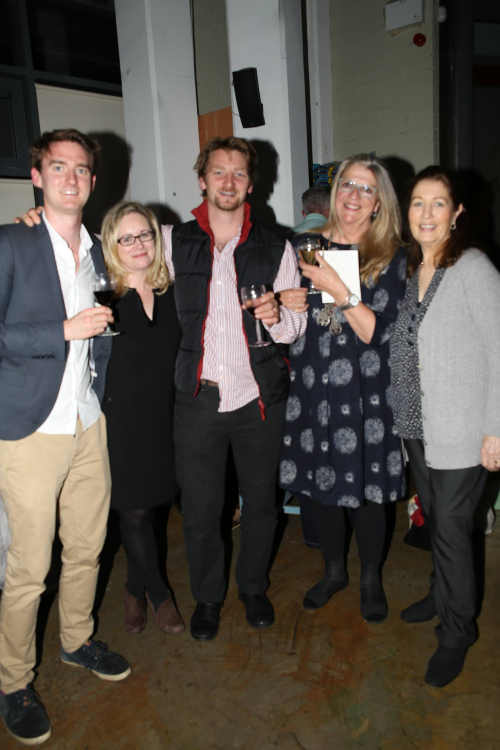 Georgina Campbell
Georgina Campbell
I have long been an admirer of the Ferguson family and have often cited their West Cork farm, Gubbeen, as a shining example of sustainable farming and quality food production in Ireland.
And now we have Giana Ferguson’s wonderful book, inviting us in to this extraordinary family home and its related businesses - the farm, run by Giana’s husband Tom and now in its sixth generation of family stewardship; the dairy, where Giana’s famous Gubbeen cheeses are made; the smokehouse, where their son Fingal produces all kinds of good things including his superb range of salamis; and the biodynamically worked acre of kitchen garden, where their daughter Clovisse produces beautiful vegetables, salads and herbs for restaurants, markets and lunches that she prepares for group visits to the farm.
In Giana’s own words: “Our formula is simple: the grass grows to feed the herd, their milk comes into the dairy where we make the cheese, and the by-product, the whey, is fed to the pigs that provide the meat for our son Fingal’s charcuterie.
Clovisse, our daughter, has been the gardener and herb grower…and is now a cook and developer of food products from our farm…How this family works and how Gubbeen manages to produce foods that are now finding their way all over the world is a fun, if rather exhausting, story. It starts in the land the Fergusons have worked for several hundred years and is the excuse for these pages, these recipes and these ideas that Tom, Fingal, Clovisse and I have developed.”
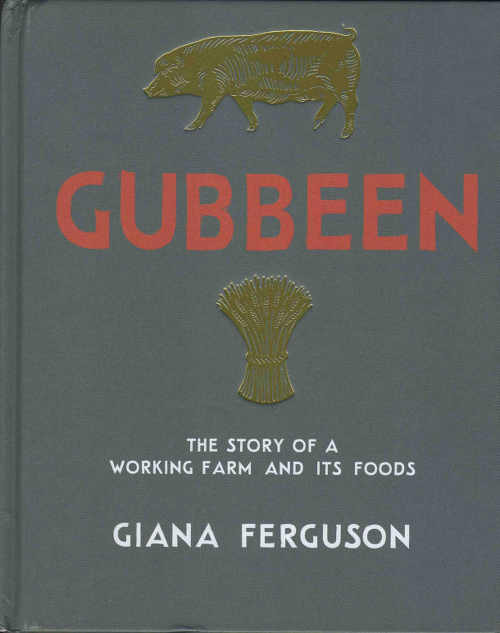 The book has clearly been a labour of love for Giana - and also for Tom, Fingal and Clovisse, who all make enormously enjoyable and insightful contributions. Tom’s chapter on Farming Gubbeen has a particular resonance for me, bringing back vivid childhood memories of a remarkably similar farm and way of life in Cornwall - we even had ‘our’ lighthouse, Godrevy in St Ives Bay, just as they have the Fastnet. I admire his steadfast belief in stewardship, resistance to dependence on new global markets, and the brave decision taken by the couple to farm for food, not commodities - which, thanks to their vision, hard work and creativity, has become such a well earned success and provided a viable way of life for generations to come.
The book has clearly been a labour of love for Giana - and also for Tom, Fingal and Clovisse, who all make enormously enjoyable and insightful contributions. Tom’s chapter on Farming Gubbeen has a particular resonance for me, bringing back vivid childhood memories of a remarkably similar farm and way of life in Cornwall - we even had ‘our’ lighthouse, Godrevy in St Ives Bay, just as they have the Fastnet. I admire his steadfast belief in stewardship, resistance to dependence on new global markets, and the brave decision taken by the couple to farm for food, not commodities - which, thanks to their vision, hard work and creativity, has become such a well earned success and provided a viable way of life for generations to come.
And then there are the recipes, which are also a true expression of their philosophy and way of life. Unlike so many others, each of the Gubbeen recipes has an original and deliciously meaningful contribution to make to our enjoyment and knowledge of food.
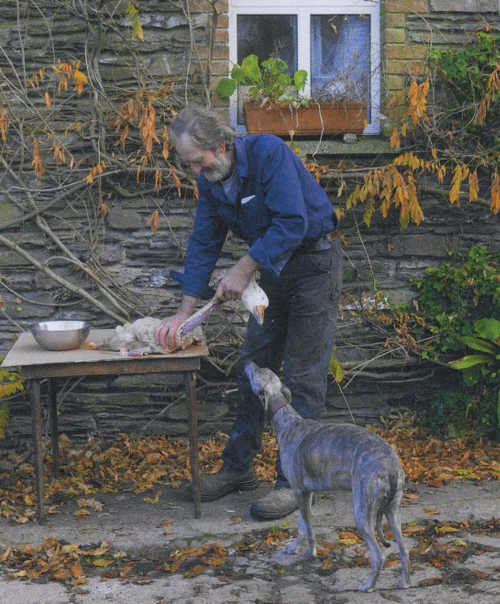 The selection below is especially relevant for the Christmas period - the goose would make a wonderful alternative festive meal for a smaller family; the Gubbeen cheese & chorizo potato cake with wilted chard is the perfect wholesome dish for a busy day - and the onion soup would be just the business when you’re fed up with fancy food (New Year, perhaps).
The selection below is especially relevant for the Christmas period - the goose would make a wonderful alternative festive meal for a smaller family; the Gubbeen cheese & chorizo potato cake with wilted chard is the perfect wholesome dish for a busy day - and the onion soup would be just the business when you’re fed up with fancy food (New Year, perhaps).
I love the simple variation from tradition - breaking up the bread topping so you don’t have a great big unmanageable layer of cheesy bread to fight through, before reaching the soup. Simply gorgeous, and so nourishing too.
I can’t commend this groundbreaking book highly enough. Visionary, inspiring and practical, there should be a copy in every school in the country - and, in every home where good food matters, it should take pride of place on the kitchen bookshelf.
Gubbeen, The Story of a Working Farm and Its Foods by Giana Ferguson, photography by Andy Sewell (Kyle Books, hard back €25)
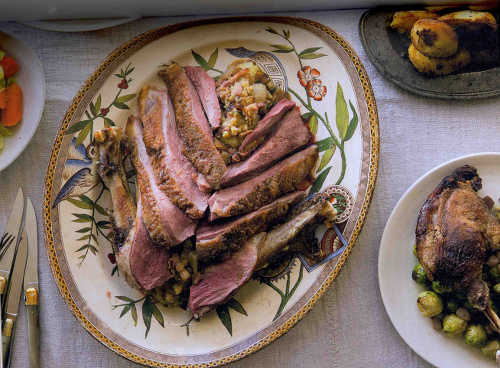 RECIPES: Roast Crown of Goose
RECIPES: Roast Crown of Goose
Goose will always be a celebration dish - the bird itself is large and its meat is very rich, so it lends itself to feeding a big table full of family.
The reason for removing the legs is that they always overcook and dry out; here you have the perfectly roasted breast and you can use the legs to make a delicious confit another day. Use the stuffing given below.
SERVES 5-6
Equipment: Digital temperature probe
1 crown of goose (about 4kg)
Salt
First prepare the Goose Stuffing (see below), and use to fill the goose cavity.
Preheat the oven to 110°C/gas mark ¼
Prick the goose skin all over with a needle. Sprinkle salt over the skin and rub it in. Place the goose, skin-side down, in a large frying pan or roasting tray and start to render the fat by cooking over a low to medium heat.
The goose will start to cook in its own fat, but if the heat is too high this won't happen and the skin will burn. You're looking for an even golden colour all over, so do move the bird around the pan to achieve this.
Place the browned crown on a rack in a roasting tin and transfer to the oven. Roast for up to 2 hours before probing with the thermometer. How long the goose will take to cook depends on the performance of each individual oven, the weight of your bird and what temperature the crown is when it goes into the oven - a digital temperature probe is essential for this method.
Probe the breast at its fattest point, stopping when you think you've reached the middle spot between the bone and the skin. If you estimate the breast is 4cm at its fattest aim to take the reading from a depth of 2cm. If the probe reads 55-56°G, it's ready. At this point remove the bird from the oven, cover and allow to rest for at least 15 minutes before carving.
Serve with Brussels sprouts and Proper Roast Potatoes.
Goose Stuffing
This is a traditional West Cork stuffing for the Christmas goose. It really complements goose as the potatoes soak up some of the wonderful fat from this rich bird. It is simple and, like many great simple dishes, it is authentic. The sage and thyme travel through the potatoes and lift the whole roast to another level.
SERVES 8
450g floury potatoes, cut into even-sized pieces
1 tablespoon olive oil
2 onions, chopped
Large bunch of fresh sage
6-8 sprigs of fresh thyme
Salt and freshly ground black pepper
Par-boil the potatoes for 10 minutes, then drain.
Meanwhile, heat the olive oil in a large pan and sauté the onions until transparent, not browned. Chop some of the sage leaves and add to the pan (keep the rest of bunch as it goes into the
cavity). Season the goose cavity.
Chop the potatoes, which should still be firm, until semi-mashed, and mix in the onions and chopped sage. Season well. Push the remainder of the bunch of sage and the thyme to the back of the goose cavity. Put in the potato stuffing, leaving a good amount of air space at the top of the cavity, which acts like an oven, while the stuffing is a sort of sponge for the goose juices
and some of its lovely fat too.
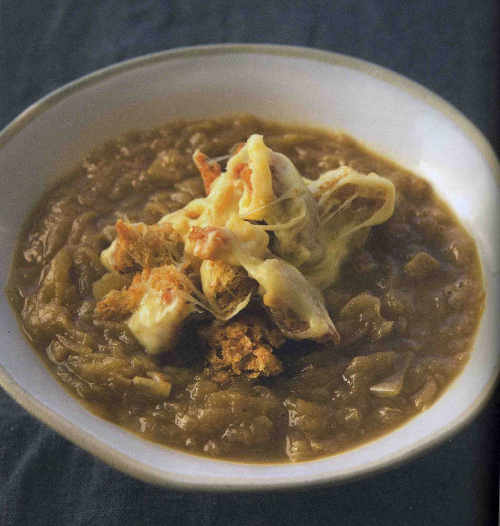 Onion Soup
Onion Soup
There is a reason why onion soup is a classic: it has a perfect flavour and it is extremely nourishing. Our addition to this lovely dish is to break the bread croutons into nice random pieces, rather than cut slices, and have lots of runny Gubbeen cheese rolling off them, which makes this very good indeed.
To get the best results from this dish use a cast-iron pan with a lid such as a Le Creuset casserole.
SERVES 4
50g unsalted butter
6 large onions, thinly sliced
1 teaspoon sea salt
1 tablespoon Mushroom Ketchup (see page 39) or sherry vinegar
1 litre beef or chicken stock
100ml brandy - more if you're in the mood
For the croutons
Handful of day-old bread, torn into bite-sized pieces
1 teaspoon mild olive oil
80g Gubbeen cheese, sliced
Preheat the oven to 200°G/gas mark 6.
Set your pan over a low heat. Heat the butter until it starts to bubble, add the onions and the salt, cover with the lid and gently steam. Remove the lid when the onions are tender and increase the heat gradually to medium, stirring until the onions turn a pleasing brown colour.
Add the Mushroom Ketchup (or sherry vinegar), pour in the stock a little at a time and work any caramelised bits from the base of the pan into the soup.
To make the croutons, toss the bread in the olive oil to coat very lightly and bake in the oven on a tray lined with parchment paper until golden. Place the cheese on top of the croutons for a minute or two until just melted.
Stir the brandy into the soup and check the seasoning. Scoop the cheesy croutons on top of the soup, and serve in the pot from the middle of the table.
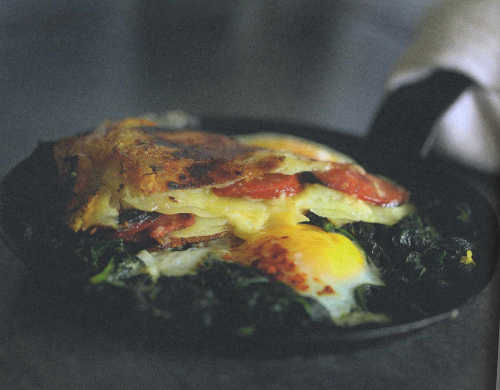 Gubbeen Cheese & Chorizo Potato Cake with Wilted Chard
Gubbeen Cheese & Chorizo Potato Cake with Wilted Chard
Having a wonderful café so near us in Durrus is a blessing. Carmel Somers is a genuine menu genius; she has a huge knowledge of flavours and comes up with natural and delicious combinations, which makes a trip to The Good Things Café such a treat; it's an education each time we go. Carmel uses sea cabbage, which grows on the strand in front of her cafe, but we always use chard.
SERVES 2
Splash of olive oil, plus extra for frying
Knob of butter
500g peeled potatoes
l00g smoked Gubbeen cheese, grated
l00g Gubbeen chorizo, sliced
2 big handfuls of chard
4 free-range eggs
Salt and freshly ground black pepper
Preheat the oven to 200°C/gas mark 6.
Heat a 20cm ovenproof frying pan on a medium heat, then melt together a good splash of oil and a knob of butter, coating the bottom and the sides of the pan with the mixture. Pour off any excess fat and keep in a bowl until later.
Lower the heat and start slicing the potatoes - they need to be very thin, but not so thin that you don't get a complete slice.
Layer the potatoes in the pan in a clockwise direction, starting from the outside and working your way into the middle, making sure you are spreading them evenly leaving no gaps. Season with salt and pepper about every third layer,
When you have layered half the potato, top with the cheese and chorizo, then continue layering the potatoes. You want to finish with a nice thick cake, so there is a contrast of crisp and soft potato. Add another potato if you think it's needed!
Brush the top with the reserved oil mixture, place in the middle of the oven and bake for 20-30 minutes until the potatoes are soft when tested with a knife.
If the top of the cake is not nice and brown, flip the cake out onto a plate or chopping board, slide back, topside down, into the pan and either return to the oven or cook on the hob on a medium heat for a few minutes.
In the meantime, cook the chard in boiling water and drain well. Heat some olive oil in a frying pan and fry the eggs.
Turn out the cake onto a plate or chopping board, cut into wedges and serve with the chard and fried eggs.





There are currently no comments
Leave a comment
Not a member? Register for your free membership now!
Or leave a comment by logging in with: